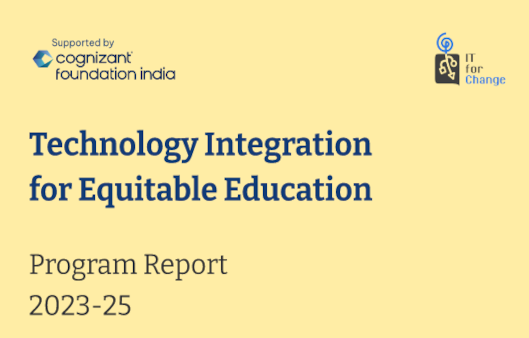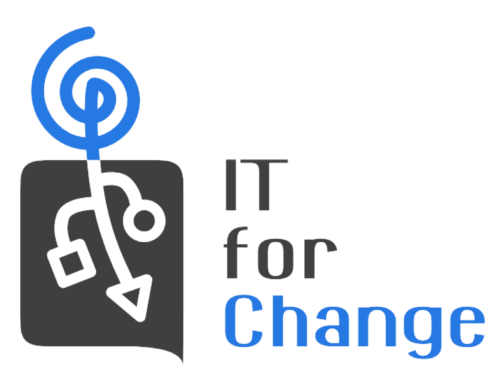The Technology Integration for Equitable Education (TIEE) program, implemented by IT for Change from July 2023 to June 2025, aimed to enhance inclusive and equitable learning in government schools across Bengaluru South and Mysuru districts in Karnataka, India. With a vision to promote equity and inclusion in education through meaningful technology integration, the TIEE program sought to transform traditional classroom practices into inclusive, engaging, and context-responsive learning environments. The program was informed by the Universal Design for Learning (UDL) framework for equitable learning, and drew from over a decade of experience in in-service teacher training and technology-enabled learning initiatives.
The program encouraged the use of Free and Open Source Software (FOSS) and technologies, and Open Educational Resources (OER) – to access and create digital materials – to enhance teaching practices and school administration processes. It focused on strengthening teachers’ abilities to use diverse pedagogies, including multi-level, multi-modal, and multilingual materials to address the academic needs of students. Additionally, the program provided opportunities to promote peer learning among teachers by fostering communities of practice.
TIEE adopted a teacher-centric model to build long-term, sustainable teaching practices through a three-pronged approach: Workshops, School Engagements and Communities of Practice (CoPs) to work with teachers. This strategy ensured that the teacher training was embedded in their contexts and pedagogical practices, moving beyond generic, one-time workshops.
Over two years, the program conducted 25 teacher workshops, 3 for headteachers, and 7 for Cluster Resource Persons (CRPs), training over 600 teachers, 92 headmasters and 165 CRPs. The workshops focused on integrating digital tools in teaching language, mathematics, and science, using simulations, storytelling, and interactive activities. They also included digital literacy workshops to help teachers use tools like spreadsheets and Google Forms for academic planning and data management.
In schools, the team worked closely with teachers to demonstrate tools like PhET (Physics Education Technology - interactive science simulations), GeoGebra(an interactive mathematics software), and StoryWeaver (a digital storytelling platform). These sessions often moved into co-teaching, where facilitators (TIEE program team members) and teachers jointly conducted classes. The digital resources were aligned with the curriculum and adapted to students’ learning needs.
CoPs were formed to enable continued peer learning and reflection among the teachers. They connected through WhatsApp groups to share their experiences, resources, and feedback. Offline-friendly digital resources were provided to ensure accessibility and encourage ongoing use.
Additional initiatives such as science camps, educational field trips, digital storytelling, and summer camps engaged students beyond textbooks with the support of Cognizant outreach volunteers. Schools also received digital infrastructure support, including setting up computer labs and installing educational applications. Parents were involved to support their children’s learning through story-based learning activities.
Teachers, headteachers, and CRPs shared positive feedback about the TIEE program, highlighting its relevance, and the accessibility of digital resources like PhET, GeoGebra, and story-based tools. These resources enhanced student and teacher engagement and improved concept clarity, especially in mathematics, science, and language. Language teachers appreciated the storytelling approach and the use of the Kathe Khajane platform (a mobile-friendly audio story repository), while mathematics and science teachers highlighted how simulations and digital resources helped students better visualize abstract concepts.
Digital literacy workshops improved teachers’ technical skills, enabling effective use of tools like spreadsheets and Google Forms for teaching and administration. Teachers observed increased student participation, especially with previously shy or struggling students becoming more confident and involved. Visual and interactive methods contributed to better understanding and improved interest in lessons.
Parents also became more engaged, particularly through audio story activities shared via mobile phones. A school headteacher reported improved enrollment driven by positive word-of-mouth and stronger community ties.
The program made classroom learning more inclusive and technology-integrated, complementing existing teaching methods and allowing teachers to adapt content to diverse classroom needs. It promoted contextual resource use and collaborative learning, supporting sustainable change in government schools. Sustaining its impact will require ongoing teacher support, digital infrastructure, and collaboration with school leadership and parents. The TIEE model offers a scalable framework for equitable education, with its strategies compiled in the TIEE Toolkit.

